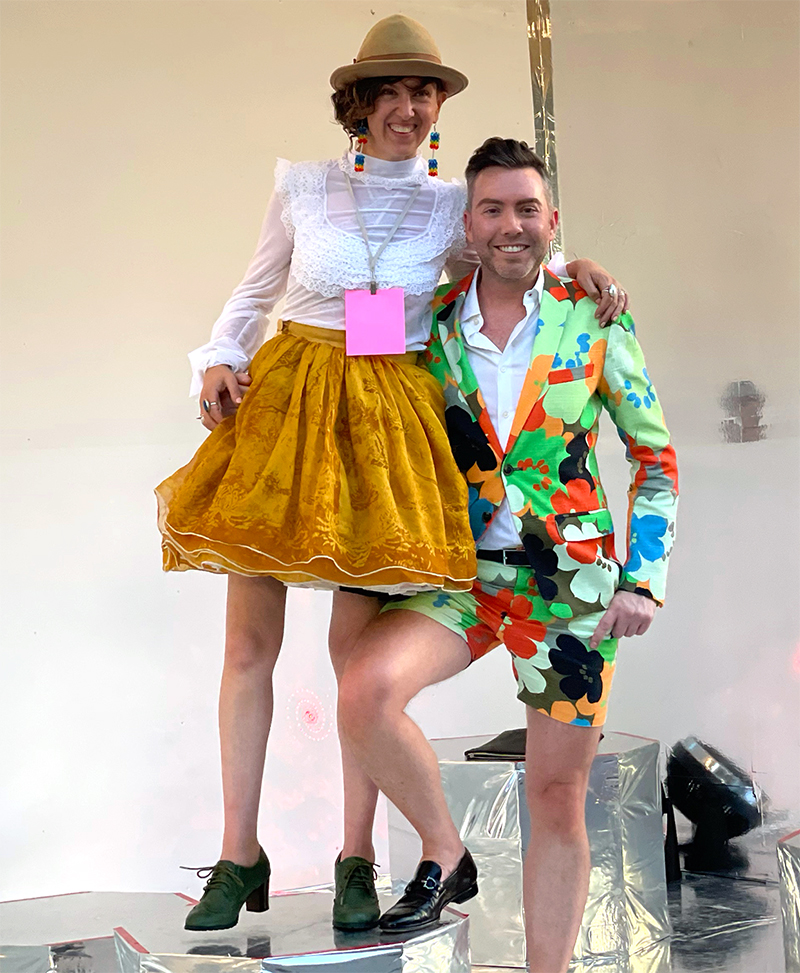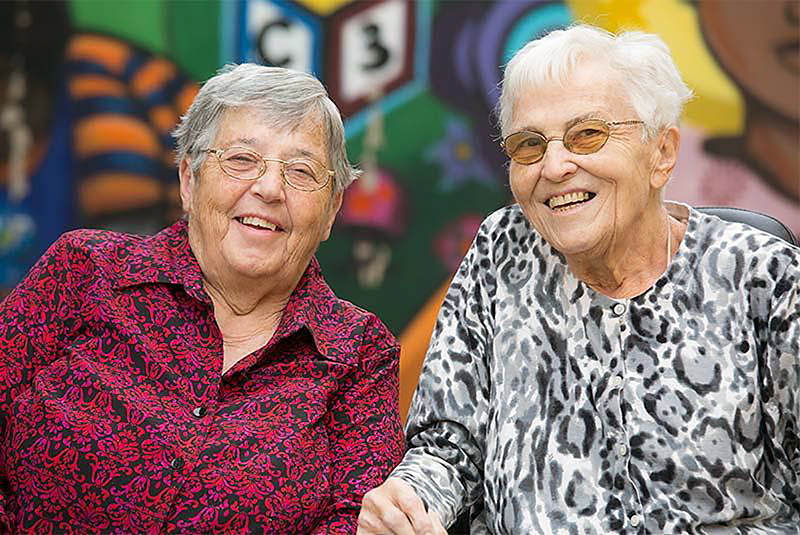
Fashion Street
Riding high on last year’s unimaginable pivot-success, the annual West 18th Street Fashion Show was back and in person (with modifications) for Summer 2021.
You may recall that last year’s transition from traditional runway show to the social-distancing-approved original film, Summer in Hindsight, premiered at a drive-in theater and resulted in an almost immediate showering of awards. Nearly a year later, the film was just accepted to the end-all-be-all Cannes International Film Festival.
This year—still a bit premature for stacked crowds (we see you, 2022!)—the organizers envisioned Summer Tableau, a pedestrian-focused trail of installation stages along that famed block of 18th Street. The inspiration: 1960’s counterculture movements. Or, as senior artistic director (and friend), Peregrine Honig described it, “The West 18th Street Fashion Show draws lines between costuming and fashion, street and cinema, sculptures and garments, gentrification and development. The collective process amplified Kansas City as a place of culture bearers, risk takers, and intuitive makers.”
Staggered along the street in these architecturally impressive stage vignettes were individual capsules from seven designers: 3 Minc, Beautiful Dissociation, Birdies, Cosmosphere, Cult of Polka, No Woe, and Reneé Larouge. Some highlights: The louche models for Birdies draped like silk across a vintage brocade sofa, bound in Japanese shibari, and dressed in delicate lingerie—the ultimate juxtaposition of power and soft vulnerability; the gigantic infinity mirror large enough to hold all of Cult of Polka’s models (including fave Logan Nichols) exhibiting evolution in their punkish, metamorphosis garments; and 3 Minc’s take on “all the juice,” which was a contemporary fashion version of my prized junior high Lisa Frank sticker box—rainbows, neon, unicorns, netting, gold foil-like leg warmers—sweet, sticky, and delicious.
Hot Gossip: Whose recent birthday party required a (gorgeously decorated) golf cart for guest transport from valet to doorstep?
After making my way through all the designers, I decided to pop up to photographer Jenny Wheat’s studio, which has a perfect bird’s-eye view of the entire street and all its happenings. We were nibbling on cheese and sipping on wine when a familiar Victorian chariot—Peregrine’s Sweet Chariot commissioned by the Nelson-Atkins Museum of Art—glided from a neighboring alley to the nondescript stage in the center of the street. Theatrically exiting was singer and harpist extraordinaire, Calvin Arsenia. He was joined on stage by Mike Dillon (in a fantastic, emerald-green caftan and cowboy hat) and Nikki Glaspie (she recently played drums on tour for Beyoncé). Together, they fired up the crowd for what then transformed into something of a street party before my very eyes. It was a sight to behold and to experience. Sound like can’t-miss fun? Well, next year’s theme is already carved in stone (literally), Summer Coliseum XXII. I’m already dreaming of the perfect, golden acanthus leaf laurel to wear. I know I have one somewhere.
Spotted: Dr. Regina Nouhan, Scott Heidmann, Ken Petti, John Rufenacht, Frances Baszta, Lee Page, Supatra Brown, Amber Botros, Daisy Chavez, Jenni McSpadden
Not long ago. Not far away.
On the eve of the public opening of Auschwitz. Not long ago. Not far away., I was fortunate to preview the exhibition at Union Station (open through January 2022). The monumental exhibit is a living memorial to the Holocaust and explores the dual identity of the camp as a physical location—the largest documented mass murder site in human history—and as a symbol of our capacity as humans for hatred and barbarity. It brings together more than 700 original objects and 400 photographs, primarily from the Auschwitz-Birkenau State Museum, making it the most comprehensive exhibition dedicated to the history of Auschwitz—and the 500-acre camp’s role in the Holocaust—ever presented in North America.
Kansas City is only the second city (following New York City) to host the exhibition. The exhibit traces the development of Nazi ideology and describes the transformation of an ordinary Polish town, where during the occupation, German Nazis created a camp at which roughly one million Jews and tens of thousands of others would be murdered. Cumulatively, more than six million Jews and up to five million other targets of Nazi ideology (Sinti and Roma, Soviets, disabled, asocials, Jehovah’s Witnesses, homosexuals, and other political prisoners) were murdered during the Holocaust.
Among the more touching artifacts on display are simple personal items, such as suitcases, eyeglasses, pots and pans, uniforms, and shoes—all belonging to survivors and victims of Auschwitz. Other artifacts include concrete posts and razor wire that were part of the camp fence, and a welded “Arbeit Macht Frei” (work sets you free) slogan that commonly arched over camp entrances (an image that remains vividly burned in my mind after visiting the Dachau camp years ago). There’s even (placed in front of Union Station) an original freight train car used for the deportation of Jews to extermination camps.
It’s also fitting that the exhibit is hosted at Union Station. It’s easy to forget that hundreds of thousands of American soldiers passed through the station on the way to two World Wars. And after the wars, it was the scene of countless, tearful reunions. Some travelers were relocated Holocaust survivors who arrived to the city with no familiar faces to greet them.
Imagine, liberated from a concentration camp, wishing to immigrate, having no identifying paperwork or ID, navigating multiple complex systems in different languages, and often no idea of where to go when arriving in America. Part of our preview visit also entailed the premiere of the Kansas City PBS documentary, All These Delicate Sorrows, which details through survivor interviews the journey from concentration camp to rebuilding lives as immigrants to Kansas City.
And why Kansas City? I was especially warmed by an interview with Bronia Roslawowski, a Holocaust survivor who immigrated to Kansas City in 1947, who (humorously) described the impulse decision made at New York Harbor: “[They said] ‘You cannot stay in New York.’ I said, show us the map. And we should look at the map. And we say, President Truman is from Missouri. Kansas City is in the heart of America. Let’s go to Kansas City! And Kansas City here I come!”
Finally, we were also able to hear from and meet several exhibit producers, including Luis Ferreiro, the director of Musealia, who co-organized the exhibit. He said, “Auschwitz did not start with gas chambers. Hatred does not happen overnight; it builds up slowly among people. It does so with words and thoughts, with small everyday acts, with prejudices… [It is] a warning of where hatred can take us to.” It makes you stop and think about that part of the exhibition title, and how not far removed we are from these acts of horror: Not long ago. Not far away.
Operation: Break. Through.
It was one of those days that I’d completely over-committed myself, but was dutifully honoring those commitments. After wrapping up a day at work, I was scrambling to finish last month’s column, throw some inspired outfits into a suitcase (ok, two suitcases) for a friend’s trip to NYC at sunrise the next morning, tick off all the remaining work items that couldn’t wait for my return, and meet my dear friend Meredith Allen for Operation Breakthrough’s annual dinner and auction event—this year celebrating the organization’s 50th Anniversary. Operation Breakthrough is the result of a rather radical undertaking (the two founders say they had no grand vision and couldn’t have seen past whatever challenges the current day would bring).
Overheard: “Anyone want breakfast? I have a shoe full of grapefruit juice.”
It all began in 1971 with Sister Corita Bussanmas and Sister Berta Sailer. They taught at St. Vincent’s, in the urban core, where they heard from parents that they needed a place to send their small children while they worked. The sisters lived together in a large house, and they thought they could surely care for some children. They scoured garage sales for what they’d need, and days later they opened. In their words (the most modest you could imagine), “We started with just four kids. And, then, we’ve grown a little bit.” Fifty years later, Operation Breakthrough is serving 700 children and 400 families every day at a 130,000 square foot (and expanding) campus at 31st and Troost.

A lot has changed from the early years, when state audits to check adult-to-child ratios meant the sisters spontaneously pulling nice-looking strangers off the street to hold children. It was a different time.
What began as a daycare for the working poor now provides early care and educational services for children between the ages of six weeks and 13 years. Before- and after-school programs also offer tutoring, play and peer groups. Wraparound services also include supportive housing assistance, parent programming like family meal-prep classes, and active fathers’ groups. Soon, due to the generous partnership of Chiefs tight end Travis Kelce and his foundation 87&Running, the Ignition Lab—a neighboring, defunct auto body shop—will become a working space for teenagers to explore careers in STEM and lessons in launching entrepreneurial ventures. Skill sets will include multimedia, automotive work, engineering, computer science, digital electronics, and will help carry students through high school.
Hot Gossip: Who threw a Café Europa lemon cake at a posh dinner party?
It goes without saying that I’ve been to a great number of fundraising events. But I can attest that I’ve never shed as many tears as I did at this one. Despite what felt like a mountain on my plate that day, it was the most freeing experience to detach and celebrate a milestone anniversary for an institution built by two indefatigable women who spent their lives providing for children, with the simple goal of building strong families. Largely, the families they serve are struggling—80% live on less than $12,000 annually. For every five children who walk through their doors, one is homeless. Homeless. But despite this, more than 90 percent of their 5 year olds test “school ready” each year, compared with fewer than 50 percent of children in poverty, nationally.
Part of the dinner program included a video that summed up Operation Breakthrough’s half a century of service to the community. At one point, I can remember a clip of pre-school-aged children chanting along with their teacher, with fervor and genuine conviction,“I am worthy. I am smart. I am equal.” An inarguable fact, and a reminder that a disparity of resources, beyond a child’s control, shouldn’t destine him or her for anything less.
Spotted: Darcy & Lindsey Stewart, Jenny Agnew, Kathy & Tom Allen, Meredith Miles
Thank Me Later
Shameless plug. Well, not really, because it is for a treasured cause. Please mark your calendar for Saturday, October 9, 2021. I, along with Emily Uhlmann Fehsenfeld and honorary chairs Helen and Frank Wewers, will be hosting the annual gala for the Kemper Museum of Contemporary Art.
This year’s event, ARTBEAT, was inspired by optimism for the future, as well as the new exhibition, Rafael Lozano-Hemmer: Pulse Topology, an immersive light and sound environment featuring 3,000 light bulbs that pulse to visitors’ heartbeats.
Overheard: “Our hotel is close to so many things. Starbucks, CVS… nice hotels.”
Attire: Exuberant Party Wear. Fun, right? Those who’ve attended for years know this: the Kemper Gala has always been a celebration—and a fashion show. Throughout history, fashion has been informed, shaped, and advanced by world events—both traumatic and hopeful. All this has creative minds wondering—how might the emergence from a year-long quarantine influence the direction of fashion? We imagine the future will be defined by exuberance. Whether it’s runway high-style, classic glamour, or impulsive creativity, here’s the key: If you have to ask “Is this too much?,” the answer is, it’s just right. Will you see me there? Obviously. Can you imagine what I’ll be wearing? Doubtful. Will I see you there? I’d better.
So, KC—where do you want to go? XO
email: dlair@inkansascity.com | Instagram: @damianlair #OurManINKC


